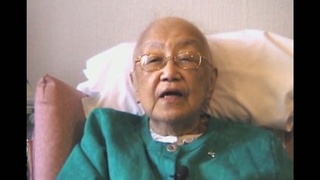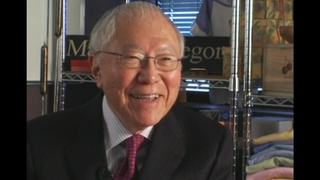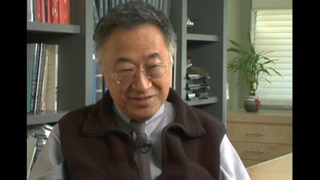Entrevistas
Immediately after the bombing
I don’t remember anything. I didn't see the flash, I didn’t hear the boom. All I know was, and I'm not sure how long after the bomb exploded, that I came to. When I came to, I was under a considerable amount of debris. Everything has fallen down on top of me. However, I was not injured, other than being unconscious for a number of minutes.
I dug myself out. Things were beginning to smoke and fire beginning to burn around me, but I was able to get out, then went up towards the court yard. And by that time Kenny came back into the courtyard from being outside the gate. And he had a small radiation burn, circular burn on his forehead. Evidently somehow the ray struck him— [a] small ray struck him in the head. But he was not severely injured.
However, my grandmother was facing a window when the explosion occurred. And all of the broken glasses were flown into her body, and she had dozens of small glasses embedded in her body. However, there were no fatal injuries, a lot of bleeding. A lot of glass would be embedded in her body. But she was functional, she was able to get up. My grandfather, I guess he was well enough to dig her out. He and a couple of other men. So he survived okay.
By that time, things were beginning to burn all around us. Every structure that we could see within our little neighborhood were burning. So my grandfather said, he and some of the men were going to try to put out the fire. We had one of those water pump[s], and they would get water and started to throw water on the fire. But not realizing the extent of the damage, the whole city was on fire. There was probably no use in doing whatever they were doing. But he told my grandmother to take the kids, us, and go toward the mountain which wasn't burning, away from the city. My grandmother took us by the hand and we walked towards the river, up towards the river where there's a street.
Fecha: September 3, 2019
Zona: California, US
Entrevista: Masako Miki
País: Watase Media Arts Center, Japanese American National Museum
Explore More Videos

Escuchar propaganda de guerra anti-estadounidense de un profesor (Inglés)
(n. 1927) Japonesa-americana nisei . Su familia regresó voluntariamente a Japón durante la Segunda Guerra Mundial.

Las penurias de la vida en Japón durante la Segunda Guerra Mundial (Inglés)
(n. 1927) Japonesa-americana nisei . Su familia regresó voluntariamente a Japón durante la Segunda Guerra Mundial.

Experiencias durante la Segunda Guerra Mundial (Inglés)
(1918-2004) Recluido en Slocan durante la Segunda Guerra Mundial. Miembro activo de la colectividad japonesa-canadiense.

Sentimiento anti-japonés en la época de la Segunda Guerra Mundial (Inglés)
(n. 1918) Empresario issei de Canadá

El impaco de Pearl Harbor en su familia (Inglés)
(n. 1918) Empresario issei de Canadá

Actividades sociales en Tashme (Inglés)
(n.1920) Japonés-canadiense nisei. Fundó la Sociedad Ikenobo Ikebana de Toronto

Opción de mudarse al este o irse a Japón (Inglés)
(n.1920) Japonés-canadiense nisei. Fundó la Sociedad Ikenobo Ikebana de Toronto

Estudios universitarios interrumpidos después de Pearl Harbor (Inglés)
(n. 1921) Empresario nisei. Fundó las tiendas "Made in Oregon”

Dificultad de conseguir trabajo durante la Segunda Guerra Mundial (Inglés)
(n. 1921) Empresario nisei. Fundó las tiendas "Made in Oregon”

La diferencia entre las experiencias vividas por jóvenes y mayores en los campos de la Segunda Guerra Mundial (Inglés)
(n.1929) Investigador pionero en la rama de medicina en el trasfiero de tejido y trasplantación de organismos.

Durante la segunda guerra mundial huir a un pueblo pequeño en las montañas
(n. 1937) Periodista profesional

Su padre en un campo pero aprendiendo de libros de historia (Inglés)
Co-fundador y editor de la revista Giant Robot

Diversión en un campo de concentración (Inglés)
Ministro del templo Budista Senshin y co-fundaror de Taiko Kinnara.

La única familia japonesa de Ocean Park (Inglés)
(n. 1934) Escritora

